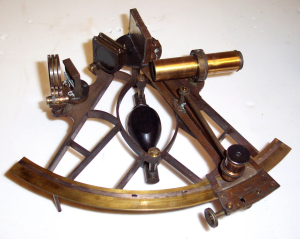¡SkyCaramba! Weekly astronomy blog for the week ending February 16, 2013
Ancient constellations are named after the animals and heroes that intrigued people who lived millennia ago. Some of the modern constellations are named after scientific instruments. One such constellation is Sextans.  It’s named after the sextant.
It’s named after the sextant.
If you’ve seen movies about sailors on journeys, set perhaps 300 years ago, you have probably seen one of the characters looking at something in a rather complex telescope. And probably, as soon as the sailor pulls the instrument away from his eye, he informs the captain or instructs another shipmate about the ship’s course. The instrument he’s looking through is a sextant.
I won’t pretend to know which movies portray accurate use of the sextant. But sailors of a few centuries ago did use such instruments to measure how high in the sky certain objects were. From this information, they could refer to a book telling where the objects should be seen from some specific latitude. By subtracting the measured altitude from the value published in the book, the navigator could determine how far north or south the ship was from the latitude set in the book’s listings.
After the invention of a very accurate spring-wound clock, navigators could also calculate the ship’s longitude. It was a slightly more complex operation. By comparing where an object should be when viewed back in the home port to where it is actually being seen from the ship, the navigator could determine how much of the earth had turned beneath the object between the two locations. In other words, he could tell how much time had passed. That’s directly related to the longitude difference.
The sextant works by letting the navigator peer straight ahead and above at an angle at the same time. Straight ahead is the horizon or perhaps a distant ship. Somewhere above is an astronomical object whose position is known. The two images, one direct and the other reflected, are brought into line. Holding or  locking the moving parts into place, the navigator then looks at the curved part of the instrument. It is marked to provide a measure of arc, as is a protractor.
locking the moving parts into place, the navigator then looks at the curved part of the instrument. It is marked to provide a measure of arc, as is a protractor.
When you read about navigational stars, you are reading about stars sailors have used to make their latitude and longitude measurements. The constellation Sextans is named after the instrument Polish astronomer Johannes Hevelius lost in a fire. You can see the faint constellation south of Leo rising in mid-evening during February. It will be on the meridian a little after midnight. In April, it’s on the meridian around 9pm.
With modern geo-positioning systems, handheld devices determine where a ship or car is by extracting information from satellite signals. A few sailors—enthusiasts we might call them—still use sextants. Mostly, it is a relic regarded in the same way as the slide rule or the sundial.
¡SkyCaramba!
http://www.pbs.org/wgbh/nova/shackleton/navigate/escapeworks.htmlhttp://www.merriam-webster.com/dictionary/sextant
http://www.clipperlight.com/howusesextant.html
http://mexicanskies.com/constellations/sextans.htm